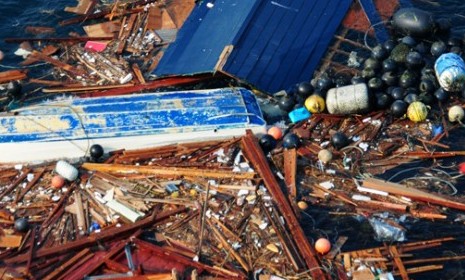Japan's 'massive' wave of tsunami debris
Millions of tons of wreckage from the March disaster is floating, slowly but surely, toward the U.S. When and where will it hit?

Japan has made great progress cleaning up after the 9.0-magnitude earthquake and deadly tsunami it endured seven months ago. But some of the aftershocks haven't yet been felt. Millions of tons of wreckage from the tsunami have been slowly drifting across the Pacific Ocean since the March disaster. Where is it headed, and when will it hit? What you need to know:
How much debris are we talking about?
Up to 20 million tons. A Russian ship spotted a field of detritus including TVs, fridges, lumber and a fishing boat emblazoned with the word "Fukushima" floating in the middle of the ocean in September, inching its way toward the Midway Islands. The wreckage is scattered across an area 2,000 miles long and 1,000 miles wide, making the debris field "twice the size of Texas," The Nature Conservancy's Mike Beck told NBC News.
The Week
Escape your echo chamber. Get the facts behind the news, plus analysis from multiple perspectives.

Sign up for The Week's Free Newsletters
From our morning news briefing to a weekly Good News Newsletter, get the best of The Week delivered directly to your inbox.
From our morning news briefing to a weekly Good News Newsletter, get the best of The Week delivered directly to your inbox.
Where is it headed?
It's expected to hit the Midway Atoll, an island halfway between Japan and Hawaii, around January. According to a computer model developed at the International Pacific Research Center in Hawaii, the "massive" expanse of flotsam will reach Hawaii in early 2013. By 2014, it will wash up on the west coast of North America, mostly in Oregon, Washington, Canada, and Alaska.
Will the slow-moving debris wave wreak havoc on U.S. shores?
Nobody can say for sure. It's not moving in a solid mass, but more like "confetti soup," says University of Hawaii computer researcher Jan Hafner. Some of the wreckage, which was sucked out to sea when the tsunami receded, has already sunk, and more could go to the bottom before the debris reaches the U.S. But much of what's floating, including chunks of wood and plastic, is bound to reach shore. "We don't want to create a panic," Hafner said, "but it's good to know it's coming."
A free daily email with the biggest news stories of the day – and the best features from TheWeek.com
Sources: ABC News, Associated Press, GlobalPost, LA Times, TIME
-
 A fentanyl vaccine may be on the horizon
A fentanyl vaccine may be on the horizonUnder the radar Taking a serious jab at the opioid epidemic
-
 The 8 best comedy TV series of 2025
The 8 best comedy TV series of 2025the week recommends From quarterlife crises to Hollywood satires, these were the funniest shows of 2025
-
 Codeword: December 16, 2025
Codeword: December 16, 2025The daily codeword puzzle from The Week